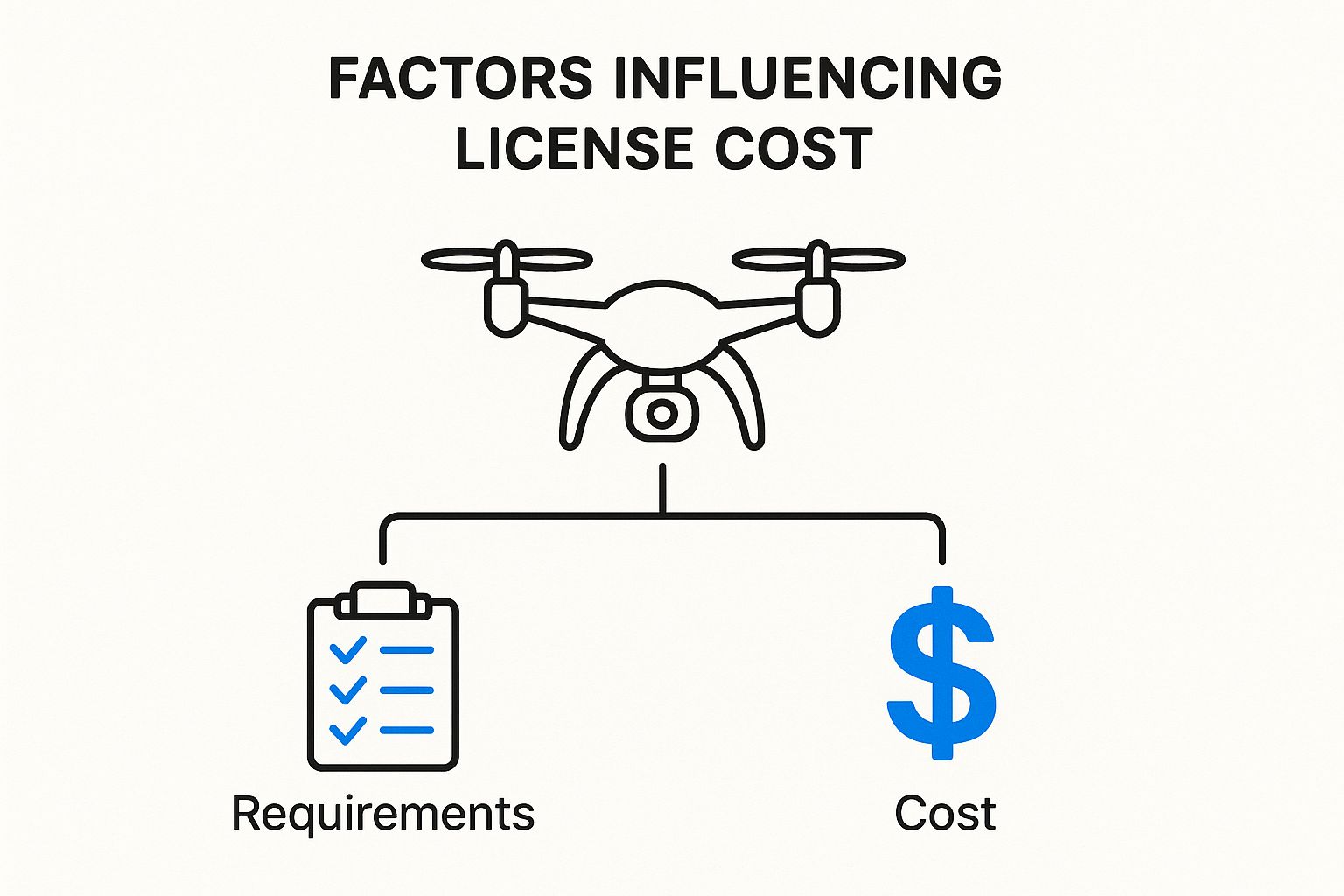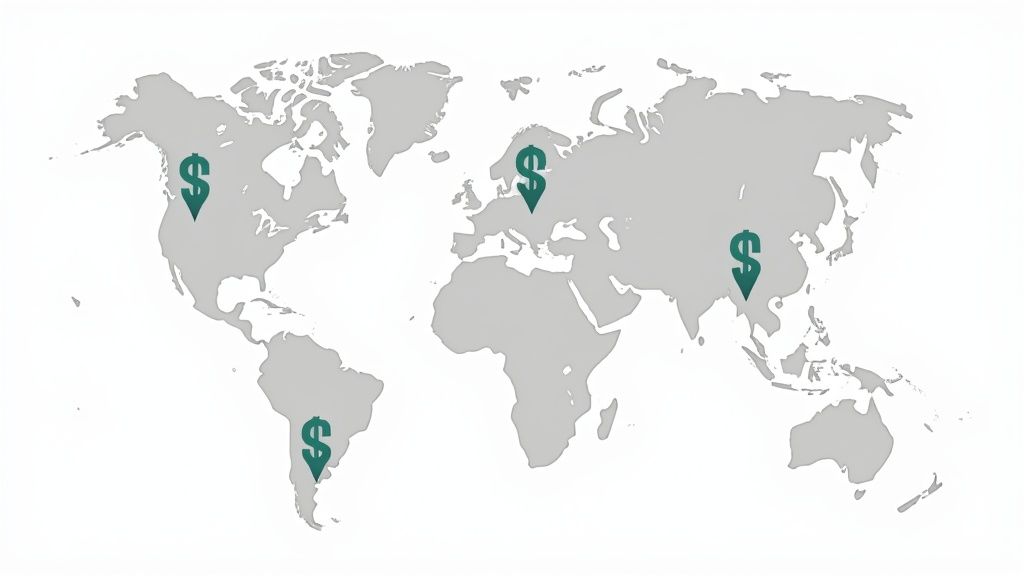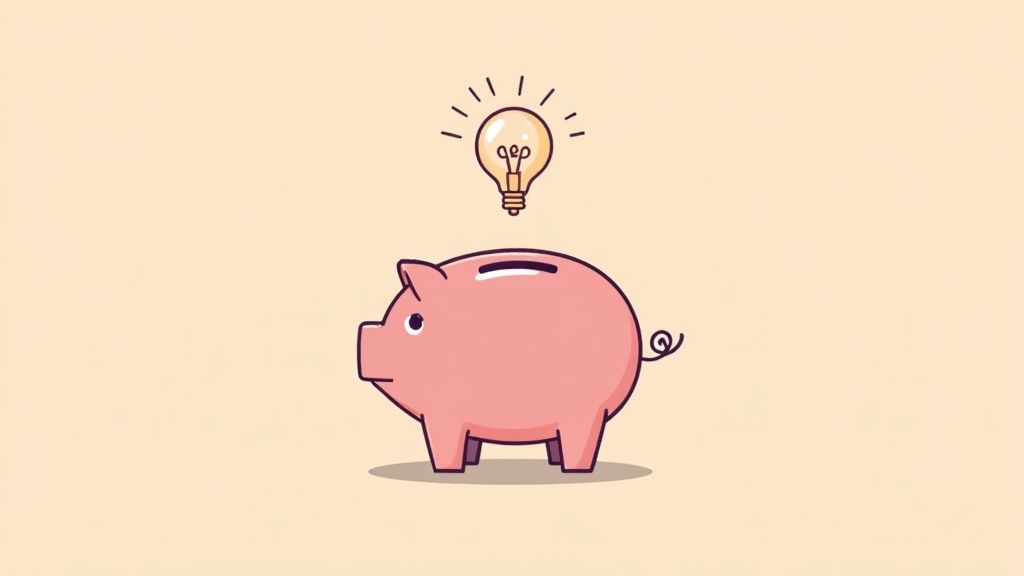Cost of Drone Pilot License: Affordable Breakdown & Tips
- James Baptiste

- Aug 9
- 9 min read
Updated: Aug 11
So, you're looking into what it actually costs to get a drone pilot license. The answer isn't a single number—it's more of a range. At the absolute bare minimum, you're looking at the mandatory FAA exam fee of around $175. But honestly, most people who are serious about this invest in some form of training to make sure they pass the first time and can fly with real confidence.
Your Realistic Drone License Cost Breakdown
Let's get straight to the point. Figuring out your drone pilot license cost is a bit like buying a car—there's the base price, but then there are the optional add-ons that really boost performance and safety. To get a handle on your total investment, it helps in understanding the difference between fixed and variable costs. The exam fee is a fixed, non-negotiable cost. Training, on the other hand, is where you have some flexibility.
Here, we'll walk through the financial side of things, breaking it down into the must-pay fees, the optional (but highly recommended) training, and other expenses you might run into.
Core License Expenses
The biggest mandatory cost for getting your drone pilot license in the U.S. is the testing fee. As of 2025, the Federal Aviation Administration (FAA) sets the price for the Part 107 Aeronautical Knowledge Test at approximately $175. This fee gets you a spot at an approved testing center and covers the required TSA background check.
Once you pass that test and get your application approved, you’ll receive a temporary certificate. This means you can start flying for commercial gigs almost right away. Think of this initial fee as the foundational investment in your new career.
This image below really helps visualize how the costs can stack up, depending on the route you take.

As you can see, your path splits right after the mandatory fee. You can either go it alone or invest in training, which is where the total cost can start to vary quite a bit.
To give you a clearer picture, here's a simple breakdown of the potential expenses you might encounter on your journey to becoming a certified Part 107 pilot.
Estimated Cost Breakdown for a Drone Pilot License
Expense Category | Typical Cost Range (USD) |
|---|---|
FAA Part 107 Exam Fee | $175 |
Online Test Prep Courses | $150 - $300 |
In-Person Training Workshops | $500 - $1,500+ |
Study Guides & Practice Tests | $25 - $75 |
License Renewal (every 2 years) | $0 (Free online recurrent training) |
This table shows how your investment can range from just the essential exam fee to a more comprehensive package that includes hands-on, expert-led training.
Your final cost really comes down to the path you choose: the bare-minimum essentials or a more thorough approach that includes professional preparation. My two cents? The total investment isn't just about passing a test; it's about building the confidence and real-world competence you need to operate safely and professionally. Good training, while optional, often saves you the cost and headache of having to re-test.
The Unavoidable Certification Fees
Every journey to becoming a commercial drone pilot starts with one non-negotiable cost: the fees required by the Federal Aviation Administration (FAA). Think of this as your official entry ticket into the world of professional drone operations. It’s the foundational investment that makes your work legal, recognized, and compliant with national safety standards.
The main mandatory expense is the Part 107 Aeronautical Knowledge Test fee, which consistently hovers around $175. This isn't just you paying to take a test; it's an investment in your legitimacy as a certified pilot. This one fee actually covers a few critical steps in your certification.
What Your Fee Includes
First off, that money pays for your proctored exam at an FAA-approved testing center. These are secure, monitored locations, which is how the FAA ensures the integrity of the test. Second, it covers the mandatory TSA background check—a standard security vetting process for all certified pilots.
Once you ace the exam, your next step is processing your application through the FAA’s Integrated Airman Certification and Rating Application (IACRA) system. This is the official online portal where your test results get verified and your final remote pilot certificate is issued. The good news? There's no extra charge for using IACRA or for the certificate itself.
The $175 test fee is the bedrock of your drone pilot license cost. It's the one expense every commercial pilot in the U.S. shares, making it the true starting point for your budget.
After passing the test and applying through IACRA, you'll get a temporary certificate, often within just a few days, which lets you start commercial work right away. Your permanent, wallet-sized card will arrive in the mail a bit later. To see how this fee fits into the bigger picture, you can check out our complete guide on the drone pilot license cost and what you need to know. This fee is your first real step toward becoming a professional, certified drone pilot.
Investing in Training to Ensure You Pass

While the FAA exam fee itself is set in stone, your investment in training is where the real cost of a drone pilot license can swing wildly. But don't just think of it as an expense; it’s an investment in your own competence and confidence. Nothing stings quite like having to pay that test fee all over again after a failed attempt.
Think of it like preparing for any big test. You could always go the free route, digging through dense FAA manuals and hoping your self-discipline holds up. This path costs you nothing but time, but it’s best suited for highly motivated people who are good at piecing together complex information on their own.
Finding the Right Training Tier
Most aspiring pilots, however, land somewhere in the middle with an online test prep course. These programs typically run from $50 to $300 and offer a clear roadmap to passing, complete with structured video lessons, tons of practice exams, and direct support. Their popularity comes down to one thing: they work. If you want to dig a bit deeper into what it takes, our proven success guide for getting a commercial drone license lays out the whole process.
For those who want the full, hands-on experience, premium in-person workshops are the top tier. These can set you back $1,000 or more, but they offer direct access to expert instructors and the kind of hands-on learning you can't get from a screen. This is a great choice if you thrive in a classroom and want to start building a professional network from day one.
The demand for skilled pilots is definitely being noticed. In 2023, the global drone training service market was valued at around $1.2 billion, with North America making up about 40% of that pie.
At the end of the day, a quality training course does more than just get you ready for an exam. It gives you a real-world understanding of airspace rules, weather patterns, and the kind of operational safety you need to fly professionally and steer clear of costly mistakes. This is about building true competence, not just checking a box.
Budgeting for Hidden and Ongoing Costs
Getting your Part 107 certificate is a huge accomplishment, but it's not the last check you'll write. The initial cost of a drone pilot license is just the starting line; being a professional involves ongoing expenses that catch a lot of new pilots by surprise. Thinking about these costs upfront will save you a lot of headaches down the road and help keep your drone business flying high.
One of the first ongoing things you'll run into is your license renewal. The FAA requires you to take a recurrent training course every 24 months to stay sharp on the latest rules and safety protocols. The great news? This is usually a free online course offered directly by the FAA, so it won’t hit your wallet.
Planning for Professional Expenses
While the renewal itself is free, other professional costs definitely aren't. If you're planning on doing any serious commercial work, drone liability insurance is completely non-negotiable. Most clients won't even talk to you without seeing proof of insurance, making it an essential business expense that protects you, them, and your gear.
Beyond just insurance, other costs start to add up and really should be part of your budget:
Drone Registration: Every drone you fly for commercial jobs has to be registered with the FAA. It costs $5 per drone and has to be renewed every three years.
Specialized Training: If you're aiming for high-value jobs in fields like agricultural surveying or thermal inspections, you’ll probably need advanced training, which comes with its own price tag.
Software Subscriptions: Professional-grade software for flight planning, processing data, and editing images often requires a monthly or annual subscription to get the good stuff.
A complete budget goes way beyond just the test fee. When you factor in insurance, software, and potential advanced training, you get a much more realistic picture of the long-term investment it takes to make it as a pro pilot.
To see how all these pieces fit together, you can unlock drone license cost secrets for pilots in our more detailed guide.
How Your Drone Choice Shapes Your Total Investment

While every commercial pilot pays the same basic fee for their Part 107 exam, the drone you choose to fly can completely change your total financial picture. It's a lot like getting a driver's license—the license itself has a set cost, but the investment for a family sedan is worlds apart from that of a commercial big rig. Your equipment and career goals will have the biggest say in what you end up spending beyond that initial certificate.
Think about a real estate photographer just starting out. They might pick up a fantastic, reliable drone for around $1,500. For them, standard Part 107 training is usually more than enough. Their main goal is to learn the rules of the sky and get great shots, which is a very common and accessible way to get into professional drone work.
When Advanced Gear Demands Advanced Skills
The numbers start to climb once you move into specialized, high-end equipment. An industrial inspector or a surveyor flying a sophisticated rig is looking at a much bigger initial investment. As the drone gets more complex and the job gets more demanding, the costs for training and licensing naturally follow suit.
For example, drones built for professional filmmaking or surveying can run anywhere from $2,000 to well over $10,000. The absolute top-tier models, like the DJI Inspire 3, can set you back about $16,500. Flying a machine like that requires a lot more than just a basic license; you'll need serious, in-depth training to handle complex jobs safely and effectively. You can always discover more insights about drone analytics on scoop.market.us to see how the industry is evolving.
Your drone isn't just a tool; it's a direct reflection of your professional specialization. The more advanced your gear, the higher the correlating costs for specialized training and insurance, transforming the basic license fee into one piece of a much larger professional ecosystem.
At the end of the day, the drone you buy defines both your budget and what you’re capable of accomplishing in the field. Understanding this link is a huge part of calculating the real-world cost of a drone pilot license and building a career that lasts.
Frequently Asked Questions About Drone License Costs
Working through the costs and rules for a drone license can definitely bring up a lot of questions. To help clear the air, I've put together answers to some of the most common things aspiring pilots wonder about. This should give you a clearer picture as you start your journey into professional drone flying.
Can I Get My Drone Pilot License For Free?
No, you can’t get the official Part 107 certificate completely free of charge. While you can find some fantastic free resources to study for the exam—like FAA manuals and online guides—one cost is simply unavoidable.
You have to pay the non-refundable FAA Aeronautical Knowledge Test fee, which usually runs around $175. This is a mandatory, fixed cost for anyone looking to get their commercial certification.
What Happens if I Fail the Part 107 Exam?
Failing the test is a frustrating and potentially expensive setback. If you don't pass, the FAA makes you wait at least 14 calendar days before you can try again. More importantly, you'll have to shell out the full exam fee for every single re-attempt.
This is a huge reason why investing in a quality training course often saves you money in the long run. It dramatically boosts your odds of passing on the first go.
Your first attempt is your most cost-effective one. The potential cost of re-testing is a hidden factor in the overall cost of a drone pilot license that many new pilots overlook when budgeting.
Is Drone Insurance Required to Get My License?
The FAA doesn't require you to carry drone insurance just to get your Part 107 license. However, the minute you start flying commercially, insurance becomes an absolute professional necessity.
Most clients will demand proof of liability insurance before they even think about hiring you. It's best to think of it less as a licensing requirement and more as a critical business expense you'll need to budget for to operate safely and protect yourself.
How Much Does It Cost to Renew My Drone License?
Here’s some great news for your wallet: renewing your Part 107 license is completely free.
To keep your certification active, the FAA requires you to complete a free online recurrent training course every 24 months. There's no fee for this renewal course or for getting your updated certificate, which makes staying current both easy and cost-effective. To see the specific steps involved, check out our quick guide on drone license requirements.




Comments